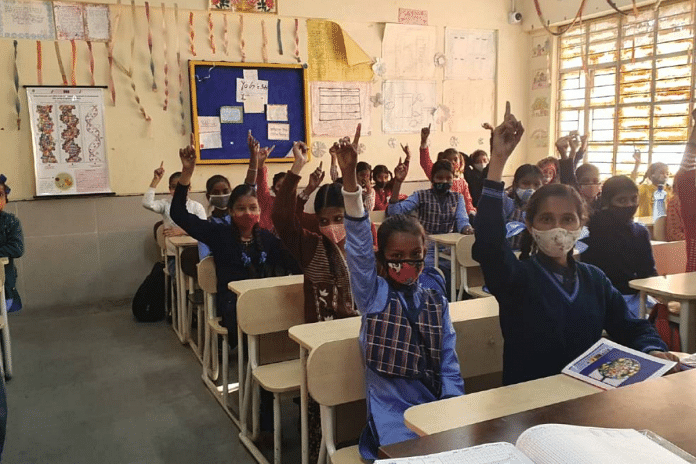New Delhi: Teaching about the lives of local heroes and including stories from the Panchatantra (a collection of Indian fables and folktales), Jataka (about the Buddha) and Hitopadesha (another collection of Indian fables) in the syllabi — this is how the draft guidelines of the National Curriculum Framework (NCF) aims to inculcate a sense of being Bhartiya (Indian) in children as young as three-to-six-year-old and instilling in them the value of “seva (service)”.
Besides, the draft guidelines also suggest that mathematics students from an early age be introduced to the contribution of Indian mathematicians like Baudhayana, Aryabhata, Brahmagupta, Bhaskara and Ramanujan.
On Thursday evening, the Ministry of Education released the draft NCF for school education and invited suggestions from stakeholders, such as students, parents, teachers and scholars.
According to the ministry, feedback is necessary given the diverse needs of students, multiple pedagogic approaches, and learning-teaching material at the different stages of school education.
The NCF draft observes that “one of the key curricular goals is for students to appreciate the importance of being an Indian by understanding the country’s glorious past and its rich diversity, geographical and cultural”.
To teach the social, cultural and technological richness of the country, students’ learning across the four stages of learning — preparatory, foundational, middle and second stage — will include stage-based scaffolded content on history, present and current India.
The NCF is being drawn up as part of the government’s new National Education Policy (NEP) 2020 — a plan that proposes sweeping reforms in the country’s education sector.
The process is led by an expert committee headed by former Indian Space Research Organisation (ISRO) chief K. Kasturirangan, who was also at the helm of shaping the NEP. The exercise is being carried out under the supervision of the National Council of Educational Research and Training (NCERT), which works on the school-level curriculum.
Also Read: Budget 2023: Digital University, announced by Sitharaman last year, to begin classes this July
Foundational and preparatory stages
In the foundational stage, students (of classes 1-2) will be introduced to local stories, music, art and games. To introduce them to the core value of “seva”, students will read texts from stories of local heroes and original stories of the Panchatantra, Jataka, Hitopadesha, and other fun fables.
At the preparatory (classes 3-5), middle (classes 6-8) and secondary (classes 9-12) stages, the disciplines in the curriculum will introduce students to diverse Indian heritage.
For the preparatory stage, the discipline of arts will include observation of local arts and cultures, and practice of basic art forms like rangoli, clay work, pottery, puppetry, folk songs and dances.
While in the discipline of mathematics, students will be introduced to major contributions made by Indian mathematicians in numeration systems.
Middle school
Middle-stage students will be expected to learn about various Indian developments in the disciplines of arts, mathematics, science, social sciences, physical education and language.
The graft guidelines also proposes that students at this stage learn and do a comparative analysis on artists and art forms across their states and also the neighbouring ones.
In mathematics, they will be able to understand the development of important mathematical ideas over a period, and locate the contribution of Indian mathematicians like Baudhayana, Aryabhata, Brahmagupta, Bhaskara and Ramanujan.
Meanwhile, in science, they will be introduced to Indian scientific ideas, which they will be able to implement in their real life. These include activities like local ways of measurement, Indian calendar system, movement of celestial bodies, among other things.
For social science, students will learn about the historical underpinnings that formed the modern Indian state, and how the idea of peace, ahimsa and co-existence have been part of Indian culture since ancient times.
Secondary stage
Students in class 9 and above will be expected to analyse the similarities and differences in art traditions from different parts of India, according to the draft guidelines.
In mathematics, they will learn about the contribution of Indian mathematicians to advanced mathematical ideas, like algebra and coordinate geometry. While in science, they will be introduced to contributions made by Indians on major scientific discoveries and ideas like astronomy, medical practice, space research.
As for social sciences, they will go into detail to understand India’s past and appreciate its rich diversity, culture, traditions, literature, philosophy, and knowledge systems.
Physical Education and language
When it comes to physical education, students in the preparatory stage will be introduced to 50 local games, added the draft NCF. Middle school onwards, they will be introduced to yoga and other complex Indian games and martial arts like wrestling, mallakhamb (wrestling on a pole), archery, chariot and bullock racing.
For languages, students at a preparatory stage will be introduced to a regional language they are most comfortable with. In later stages, they will be introduced to two other languages.
“Learning in the mother tongue or a familiar language (R1) till the foundational stage will keep students connected to their cultural heritage. R1, which is most often the regional language, will help students form a deeper understanding and connect,” the NCF read.
“Exposure to other two languages (R2 and R3) will help students become multilingual, appreciate diversity and help form a national identity,” it added.
(Edited by Richa Mishra)
Also Read: Top education body CABE hasn’t met since 2019 & Modi govt won’t say why



